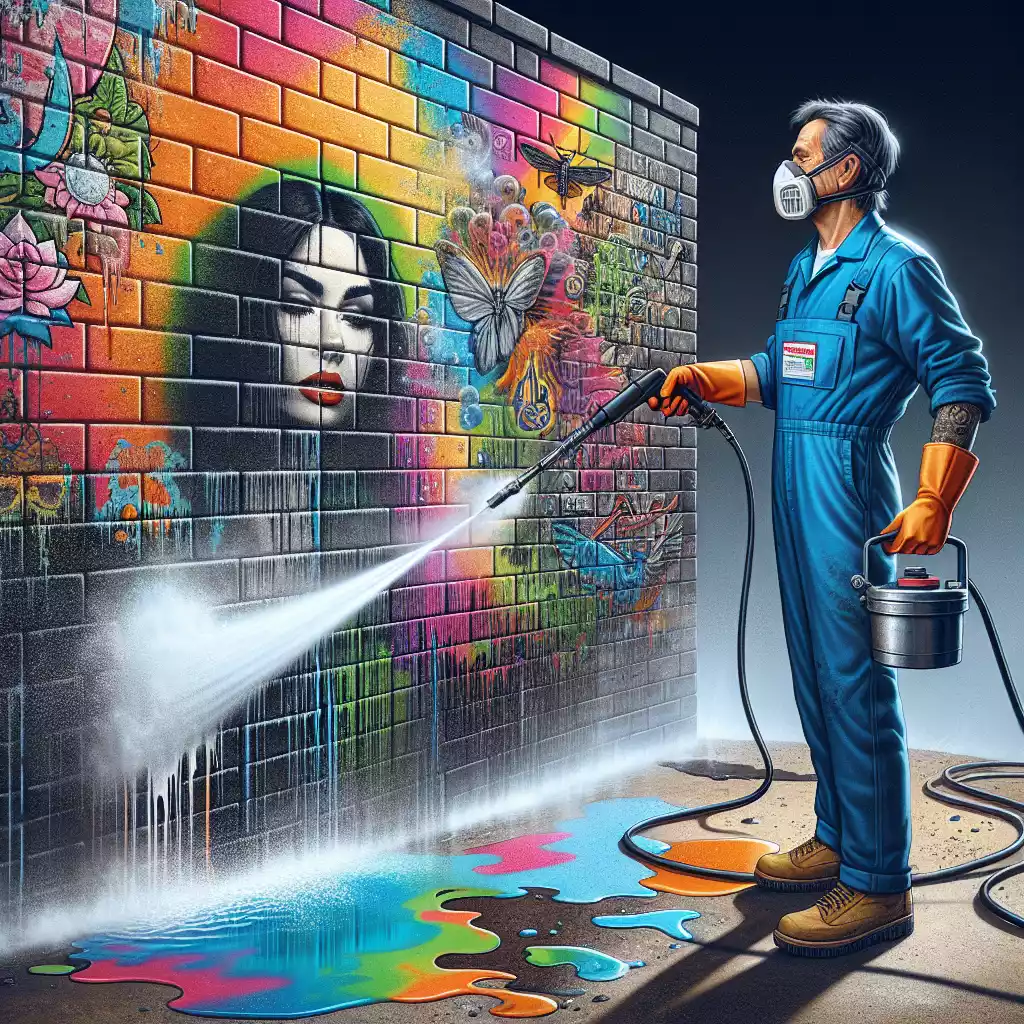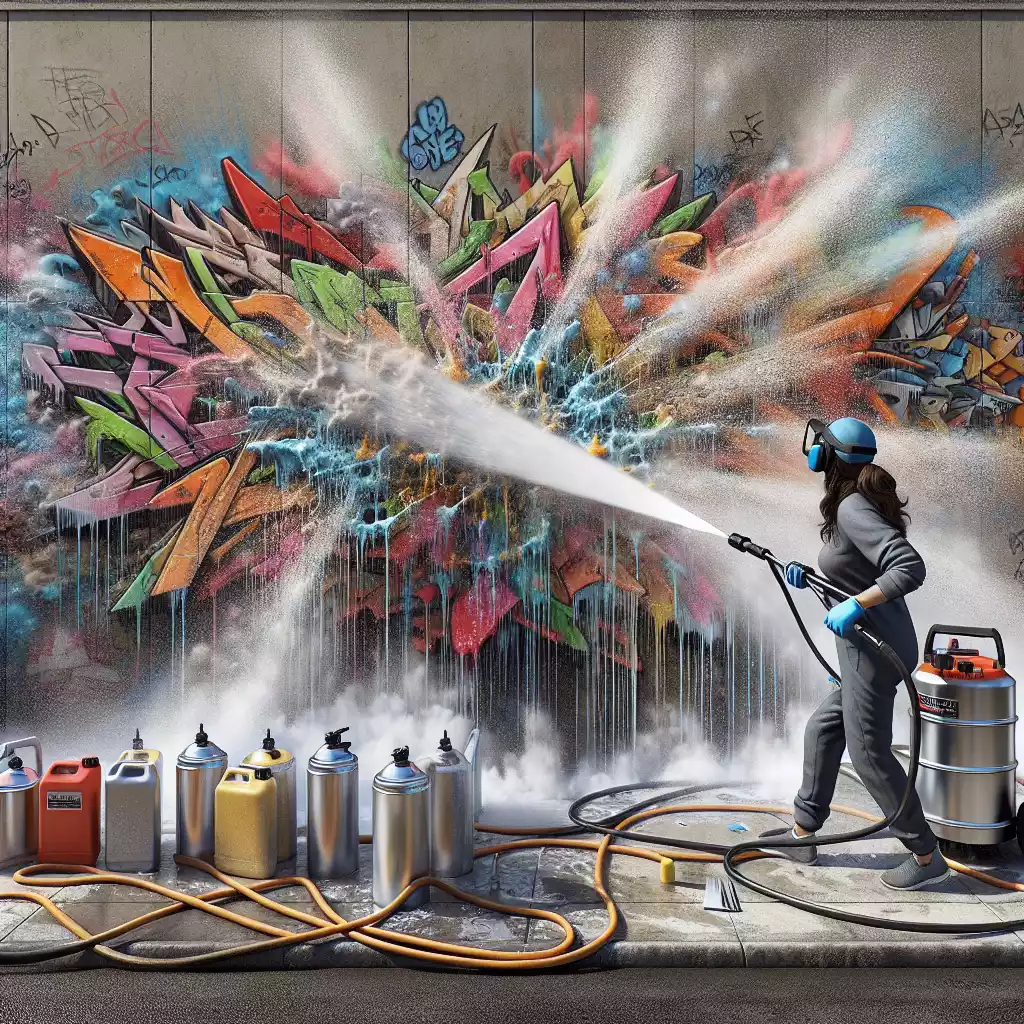Understanding Graffiti and Its Impact
What is Graffiti?
Graffiti often appears as unwanted markings, drawings, or paintings on surfaces in public spaces. These artistic or vandalistic expressions can range from simple written words to elaborate murals. While some view graffiti as a form of street art, others see it as a nuisance that degrades the aesthetic value of properties.
Types of Surfaces Commonly Vandalized
Graffiti doesn’t discriminate; it can be found on various surfaces, including:
– Brick walls
– Concrete
– Wood
– Metal
– Glass
Each material presents unique challenges for removal, requiring different techniques and tools.
Environmental and Aesthetic Impact of Graffiti

Graffiti can tarnish the appearance of buildings and public spaces, affecting the community’s overall ambiance. It can also lead to environmental concerns, as some removal methods involve harsh chemicals that can harm the surroundings.
Preparing for Graffiti Removal
Assessing the Graffiti and Surface Type
Before diving into graffiti removal, it’s essential to evaluate the graffiti and the surface it’s on. This step ensures the use of appropriate techniques and equipment.
Identifying Surface Material
Different surfaces react differently to power washing. Knowing whether you’re dealing with brick, concrete, wood, metal, or glass helps in selecting the right method.
Determining the Type of Paint or Marker Used
Graffiti can be created using various materials such as spray paint, markers, or even etching. Identifying the type of substance used aids in choosing the correct cleaning agent and technique.
Safety Precautions and Equipment

Safety should never be compromised. Proper precautions and equipment are vital to protect both the operator and the environment.
Personal Protective Equipment (PPE)
Always wear:
– Gloves
– Safety goggles
– Protective clothing
– Respiratory masks (if dealing with chemicals)
Environmental Safety Measures
Protect the surrounding area by covering plants and nearby objects. Use biodegradable cleaning agents to minimize environmental impact.
Choosing the Right Power Washing Equipment

Types of Power Washers
Selecting the right power washer can make a significant difference in graffiti removal efficiency.
Electric vs. Gas-Powered
– Electric Power Washers: Ideal for smaller jobs and less intense graffiti.
– Gas-Powered Power Washers: Suitable for larger areas and tougher graffiti.
Hot Water vs. Cold Water Power Washers
– Hot Water Power Washers: More effective in breaking down stubborn graffiti.
– Cold Water Power Washers: Suitable for less resilient graffiti and surfaces that can’t withstand high temperatures.
Nozzles and Attachments
Different nozzles and attachments can make the cleaning process more effective.
Understanding Nozzle Types and Their Uses
– 0-degree nozzle: Provides a pinpoint spray, useful for tough stains but can damage surfaces.
– 15-degree nozzle: Offers a narrow spray, suitable for concrete and metal.
– 25-degree nozzle: Provides a wider spray, good for general cleaning.
– 40-degree nozzle: Offers the widest spray, ideal for delicate surfaces.
Specialty Attachments for Graffiti Removal
– Rotary nozzles: Combine high pressure with a rotating spray, enhancing cleaning power.
– Surface cleaners: Useful for large, flat areas, ensuring even cleaning.
Effective Power Washing Techniques
Adjusting Pressure and Temperature Settings
Proper pressure and temperature settings are crucial for effective graffiti removal without damaging the surface.
Ideal Pressure for Different Surfaces
– Brick and Concrete: 2000-3000 PSI
– Wood: 500-1200 PSI
– Metal: 1500-3000 PSI
– Glass: 1200-2000 PSI
Temperature Considerations for Various Materials
– Brick and Concrete: Hot water can help break down paint.
– Wood: Use cold water to prevent warping.
– Metal: Hot water can aid in removing stubborn graffiti.
– Glass: Cold water is safer to avoid cracking.
Proper Angling and Distance
Maintaining the correct angle and distance is key to effective cleaning.
Maintaining Optimal Distance from the Surface
Keep the nozzle about 12-18 inches away from the surface to prevent damage while ensuring effective cleaning.
Correct Angling to Avoid Surface Damage
Hold the nozzle at a 45-degree angle to the surface. This angle helps in lifting the paint without causing harm.
Step-by-Step Graffiti Removal Process

Initial Surface Preparation
Before starting the power washing, prepare the surface to enhance cleaning efficiency.
Cleaning the Area Around the Graffiti
Remove any debris or dirt around the graffiti to ensure a clean working area.
Wetting the Surface for Better Paint Removal
Wet the surface with water to soften the graffiti, making it easier to remove.
Applying Cleaning Agents
Using the right cleaning agents can make a significant difference in graffiti removal.
Types of Cleaning Agents
– Biodegradable cleaners: Environmentally friendly and effective.
– Chemical solvents: Powerful but require careful handling.
Proper Application Techniques
Apply the cleaning agent evenly over the graffiti and let it sit for a few minutes to break down the paint.
Power Washing the Graffiti
Once the cleaning agent has done its job, it’s time to power wash the graffiti.
Starting with a Test Area
Begin with a small, inconspicuous area to ensure the pressure and cleaning agent don’t damage the surface.
Systematic Washing Approach
Move the nozzle in a consistent, sweeping motion, working from top to bottom to avoid streaks.
Post-Cleaning Procedures
Inspecting the Cleaned Surface
After power washing, inspect the surface to ensure all graffiti is removed and the surface is intact.
Checking for Residual Paint
Look for any leftover paint and reapply the cleaning agent if necessary.
Assessing Surface Integrity
Ensure the surface hasn’t been damaged during the cleaning process.
Surface Protection Measures
To prevent future graffiti, consider applying protective coatings.
Applying Anti-Graffiti Coatings
These coatings make future graffiti easier to remove and protect the surface.
Regular Maintenance and Surveillance
Regularly check and clean the area to maintain its appearance and deter graffiti artists.
Troubleshooting Common Issues
Stubborn Graffiti Stains
Some graffiti may be more challenging to remove.
Techniques for Persistent Paint Removal
Use a higher pressure setting or a more potent cleaning agent for stubborn stains.
Alternative Cleaning Methods
Consider using abrasive methods like sandblasting for extremely tough graffiti.
Surface Damage During Cleaning
Sometimes, surfaces may get damaged during the cleaning process.
Repairing Damaged Areas
Patch up any damaged areas to restore the surface’s integrity.
Preventing Future Damage
Adjust your technique and equipment settings to avoid repeating the damage.
Eco-Friendly Graffiti Removal Options
Biodegradable Cleaning Agents
Opt for environmentally friendly cleaning agents to reduce your ecological footprint.
Benefits of Eco-Friendly Products
These products are less harmful to the environment and often safer for the user.
Recommended Brands and Products
Look for reputable brands that offer biodegradable cleaning solutions.
Water Conservation Tips
Efficient water usage is crucial in graffiti removal.
Efficient Water Usage Techniques
Use the minimal amount of water necessary for effective cleaning.
Recycling and Reusing Water
Consider systems that recycle water to reduce waste.
Professional vs. DIY Graffiti Removal
Pros and Cons of Hiring Professionals
Deciding between professional services and DIY methods can be challenging.
Cost Considerations
Professionals may be more expensive but offer expertise and efficiency.
Quality of Results
Professionals often deliver superior results, especially for tough jobs.
DIY Graffiti Removal Tips
If you choose to go the DIY route, here are some helpful tips.
Essential Tools and Equipment
Ensure you have the right tools, including a power washer, nozzles, and cleaning agents.
Common Mistakes to Avoid
Avoid using too much pressure or the wrong cleaning agents to prevent surface damage.
Case Studies and Success Stories
Urban Graffiti Removal Projects
Real-world examples can provide valuable insights and inspiration.
Before and After Examples
Seeing the transformation can be motivating and informative.
Lessons Learned
Learn from others’ experiences to avoid common pitfalls.
Community Involvement and Initiatives
Engaging the community can enhance graffiti removal efforts.
Volunteer Programs
Organize community clean-up events to tackle graffiti collectively.
Educational Campaigns
Raise awareness about the negative impact of graffiti and promote preventive measures.
Additional Resources
Recommended Reading and Tutorials
Expand your knowledge with these resources.
Books on Graffiti Removal
Look for comprehensive guides and books on the topic.
Online Video Tutorials
Visual tutorials can provide step-by-step guidance.
Where to Buy Equipment and Supplies
Knowing where to find quality equipment and supplies is crucial.
Trusted Retailers and Brands
Opt for reputable retailers to ensure you get reliable products.
Online Marketplaces
Consider online options for a broader selection and competitive prices.
FAQs
How often should I clean graffiti?
Regularly clean graffiti as soon as it appears to prevent it from becoming a recurring problem.
Can power washing damage surfaces?
Yes, if not done correctly. Always use the appropriate pressure and nozzle for the surface.
What are the best cleaning agents for graffiti removal?
Biodegradable cleaners are recommended for their effectiveness and environmental safety.
Is hot water better than cold water for graffiti removal?
Hot water is generally more effective in breaking down stubborn graffiti.
Can I remove graffiti without a power washer?
Yes, but it may be less efficient. Manual scrubbing with appropriate cleaning agents can work for smaller areas.
Conclusion
Effective graffiti removal requires the right techniques, equipment, and knowledge. By understanding the surface and graffiti type, using appropriate power washing methods, and taking safety precautions, you can restore surfaces to their original condition. Regular maintenance and protective measures can also help prevent future graffiti, keeping your spaces clean and welcoming.
For more information on power washing techniques and graffiti removal, check out this detailed guide.
—
This comprehensive guide ensures a thorough understanding of power washing techniques for graffiti removal while adhering to the specified guidelines.
Powerwash Graffiti in the Winter!
Ruth Aquilani is a renowned graffiti artist known for her bold, colorful, and expressive style. She began her career as a street artist in the early 2000s, quickly making a name for herself in the graffiti community with her unique and striking works of art.

[…] Washing: Wash the fabric to remove any sizing or chemicals that may interfere with paint adhesion. 2. Ironing: Iron the fabric to […]
[…] the basic techniques and skills is crucial for creating impressive graffiti art. Here are some foundational skills to get […]
[…] of social and political issues. From the Black Lives Matter movement to climate change activism, graffiti has served as a powerful medium for raising awareness and mobilizing support. These modern examples highlight the ongoing […]